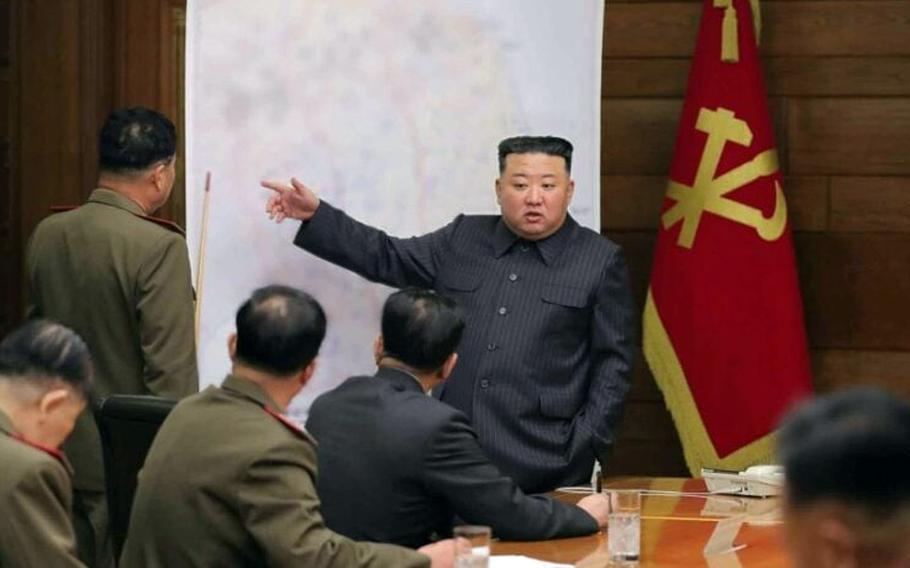
North Korean leader Kim Jong Un appears to point to a spot south of South Korea's capital in this image released by the state-run Rodong Sinmun newspaper on April 11, 2023. (Rodong Sinmun)
TOKYO — A North Korean missile launch Thursday morning prompted the Japanese government to warn residents on the northern island of Hokkaido to take shelter, a warning it retracted within minutes.
South Korea’s military detected one medium- to long-range ballistic missile fired from near Pyongyang at 7:23 a.m., according to a message to reporters from the country’s Joint Chiefs of Staff. It flew an estimated 620 miles.
About a half-hour later, Japan’s alert system warned everyone on Hokkaido to take cover.
“Evacuate immediately,” a 7:55 a.m. alert said. “Evacuate inside buildings or basements immediately. A missile is expected to drop around Hokkaido around 8 a.m. Evacuate immediately.”
The government later updated its alert to say the missile had “no possibility of landing in Hokkaido or near Hokkaido after confirming information.”
Japan Railways stopped all of its Hokkaido trains around 8 a.m., according to NHK. Hokkaido Broadcasting reported that commuter trains resumed operation 23 minutes later.
The Japan coast guard at 8:19 a.m. announced that the missile seemed to have come down, according to public broadcaster NHK, but the report did not specify where.
Japanese Defense Minister Yasukazu Hamada told reporters the missile was fired at a high angle and that it did not impact in Japanese territory or its maritime exclusive economic zone.
Thursday’s warning is at least the seventh alert by the Japanese government following a North Korean missile launch, according to NHK. The last alert occurred at 7:50 a.m. Nov. 3, after North Korea fired an intercontinental ballistic missile from its western coast. In that case, Tokyo issued alerts for three prefectures it believed the missile would pass over.
The launch Thursday is North Korea’s 12th in nine separate days of testing. The communist regime last fired two short-range ballistic missiles on March 27.
South Korea “maintains a full readiness posture” and is “closely cooperating with the U.S.” in assessing the launch, the joint chief’s message said.
The ballistic missile could be a “new type” that is propelled by solid fuel, a South Korean defense official speaking on the customary condition of anonymity told Stars and Stripes by phone Thursday.
Solid fuel ICBMs are launched faster and require less maintenance than liquid-fuel rockets. The South Korean military in its 2023 defense white paper said the North developed its solid-fuel missile program “in a short period of time” and the regime is expected to replace its older, liquid-fueled missile inventory with the newer missiles.
The launch did not “pose an immediate threat” to the U.S. or its allies, according to a statement from the U.S. Indo-Pacific Command, but it “highlights the destabilizing impact” of North Korea’s “unlawful” programs to develop ballistic missiles and weapons of mass destruction.
The launch occurred as South Korea’s military holds a five-day exercise with local first responders in and around Daegu. The annual drills address scenarios including air raid drills, and terrorist and cyber-attacks.
It also comes roughly a week after U.S. and South Korean forces wrapped up their Ssangyong Exercise, a series of large-scale maritime drills. That exercise followed a series of large-scale army and air force drills throughout the country last month, including Warrior Shield, in which 1,200 troops fired U.S. M777 and South Korean K-9A1 howitzers.
The exercises “showcased alliance readiness and capabilities” and the two militaries “concurred on the need to conduct practical combined exercises and trainings during the latter half of the year,” according to a joint statement Thursday from the National Defense Ministry and the U.S. Defense Department.
North Korea’s state-run Korean Central News Agency described the drills as a rehearsal of an invasion and likened them to a declaration of war. The U.S. and South maintain that the training is a defensive exercise meant to bring stability to the region.
South Korea’s Ministry of Unification on Thursday said the North remained unresponsive for its daily phone call with Seoul for the seventh straight day. The short calls, one each in the morning and evening, ensure a line of communication remains open between Seoul and Pyongyang.
“The government expresses strong regret over North Korea’s unilateral and irresponsible attitude, and strongly warns that it will eventually isolate and put itself in a predicament,” a ministry statement said.